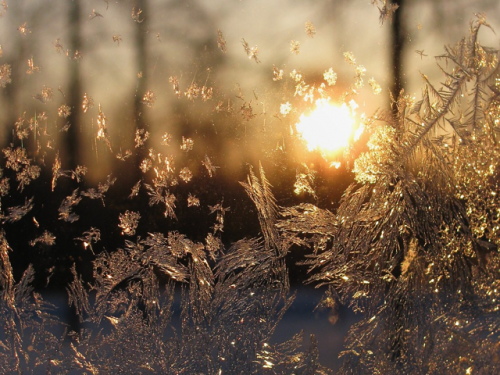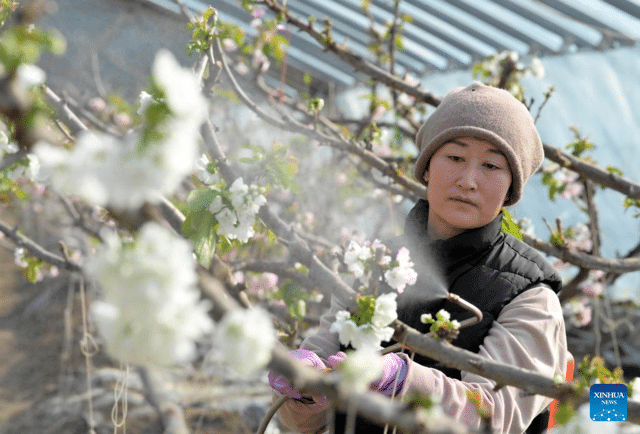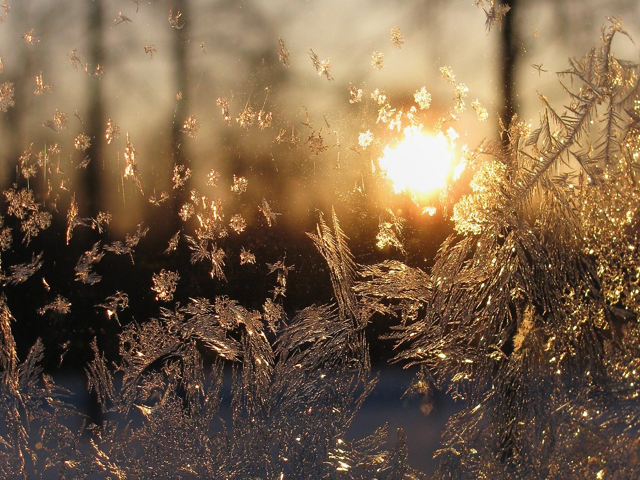Well, the weather hasn’t improved much over the past month. Today, as I am writing this there is a cold wind blowing and though the sun is shining, it’s bitter in the north wind coming across the fields. But at least the sun is shining!

Still not good enough for the bees. If their body temperature drops below about 7°C, they will die. Over the past few weeks, though, they have had the chance to get out in the milder weather in between showers and have been bringing in pollen and nectar from the early flowers of gorse and willow.
Our viburnums are in flower and these also provide nectar for the bees, so they’re not doing too badly – if the weather allows it!
Keeping larvae alive – check your hives
The problem is, at this time of year, the queen is starting to get into her stride again, laying a lot more eggs than she has for several months which hatch into larvae – which in turn need feeding. As the number of hatched larvae increases, the amount of food required is greater, and if the bees have either not got enough winter stores or the opportunity to get out and gather pollen and nectar for them, the larvae will starve and die, resulting in a diminishing number of bees in the hive. Small colonies find it harder to survive and the stress of diminishing food availability leaves them susceptible to disease. This is not transmitted disease, like flu is with us, but endemic disease, disease pathogens which are latent in the bees but come to the fore when they are under stress. So checking the hive at this time of year is key to a successful colony coming through the winter and going on to become a prosperous colony in the summer in terms of bee numbers and honey production.

The importance of producing local honey
Whilst honey production is not necessarily the reason people keep bees (I’ve always felt their importance to the ecological environment is more important in terms of their pollinating capabilities, so honey is a bonus), but for the commercial beekeeper honey is what keeps most of them in business. After all, the global honey market achieved a revenue of US $9.3 billion in 2023, which is expected to increase to US $9.8 billion in 2024. This trend is forecast to continue with US $10.3 billion in 2025, US $10.8 billion in 2026 and US $11.4 billion in 2027. Of this, 78% market share is attributable to organic honey, indicating a strong preference among consumers for natural and sustainably produced honey products. This global production of natural honey is led by China who produced 472,700 metric tonnes of honey in 2021 – unfortunately, though we have a wealth of beekeeping talent here in the UK, we have a very short honey flow season (basically, just in July), so our contribution to this global market is very small, if not negative, as we have to import most of the honey we use. In 2022, the UK imported 51,912 tonnes of honey, up from the previous years of 50,000 tonnes between 2018-2022, and mainly from New Zealand, China, Mexico, Spain and Poland. We are actually the second largest importer of honey in Europe!
So what can we do about this? Well, education is the starting point, both through the beekeeping associations and, more importantly perhaps, schools. We need to increase the number of beekeepers, and whilst we generally cannot claim to produce organic honey, we can and do produce the next best thing – a sustainable and natural product, obtained without the use of chemicals or the bulking out of our product with artificial sweeteners like High Fructose Corn Syrup. One of my current students said to me last week that, after tasting the honey she bought from me, she threw out the jar of supermarket honey that was in her cupboard! Quite right too! Good girl!
The multifaceted nature of honey
Honey, a natural and sweet substance, is not only known for its delightful flavor but also for its nutritional composition. It contains a minimal amount of protein, is virtually fat-free, containing no total lipids (fat). Its predominant component is carbohydrates, so serves as a source of quick energy due to its high sugar content. While it doesn’t provide a significant amount of dietary fibre, it offers trace minerals such as calcium, iron, magnesium, phosphorus, potassium, and trace amounts of zinc, copper, manganese, and selenium.
In terms of vitamins, honey contains minimal amounts of vitamin C, thiamin, riboflavin, niacin, pantothenic acid, vitamin B-6, and a small quantity of folate. Honey is cholesterol-free and does not contain significant amounts of saturated, monounsaturated, or polyunsaturated fats. Additionally, it does not provide vitamins A, E, B-12, K, retinol, or any notable carotenoids. Honey’s nutritional profile reflects its natural sweetness and serves as a versatile ingredient in a wide range of culinary applications while offering some trace minerals and a source of carbohydrates for energy.
Over the past few years, from 2015-2021, extensive research has shed light on the diverse constituents of honey and its potential health-promoting effects, reaffirming its nutritional value. Sugars and related compounds constitute a significant portion, accounting for 30% of honey’s composition, which provides a sweet taste and serves as a source of energy. Amino acids and proteins make up 20%, offering essential building blocks for the body’s tissues and contributing to honey’s potential nutritional benefits. Lipids and related compounds, comprising 18%, provide some fats and lipid-based compounds, which, although in smaller quantities, contribute to the overall nutritional profile. Vitamins, constituting16%, impart essential micro-nutrients to honey, enhancing its appeal as a wholesome food. Phenolic compounds, at 8%, bring antioxidant properties and potential health benefits, while another 8% encompasses various other compounds, further diversifying honey’s nutritional content.
These findings underscore the multifaceted nature of honey, emphasizing its value not only as a natural sweetener but also as a source of potential health benefits due to its rich and varied constituents. However, all this requires the presence of bees

Pollinating cherry blossom
Greenhouse production of fruit and veg crops, in the meantime, continuously increases. But it can’t increase unless there is adequate ‘pollination’. Having natural pollination by bees doesn’t work well in the controlled space of a greenhouse. So, pollen is collected from male flower parts, the anthers, mixed in an aqueous solution and sprayed on flowers having (female) stigma. In this photo “A farmer pollinates cherry blossoms at a greenhouse in Ciyutuo Town of Luanzhou, north China’s Hebei Province, Jan. 29, 2024.” China has had to resort to hand-pollination for many years now, owing to their high bee losses (yet they are still a major honey exporter worldwide!). When we get to that point in the world environment then we’ll really have problems and the benefits of honey will no longer be available to us. Remember Einstein’s comment – “If the honey bee dies out, mankind will follow within four years”. I don’t think I even want to know that! So look after our bees. Plant flowers and shrubs that are nectar and pollen sources for them, not those that produce, blousy, showy blooms. Invariably, these kinds of flowers are of no use whatsoever to the bees, as they have been hybridised for looks not practicality.
Finally, the Asian Hornet queens will be emerging from hibernation very shortly, looking for sugary food to help them build up energy for starting their embryonic nest. Please keep a look out for them and report if an unfamiliar insect is seen, about 3cm long, mainly black abdomen with a single yellow stripe – and yellow legs.

Report immediately if seen, otherwise we could end up in the situation faced by several European countries and the Isles of Jersey, where Asian Hornet is decimating the bee populations.
Colin Rees 07939 971104 colinbeeman@aol.com 01872 501313

